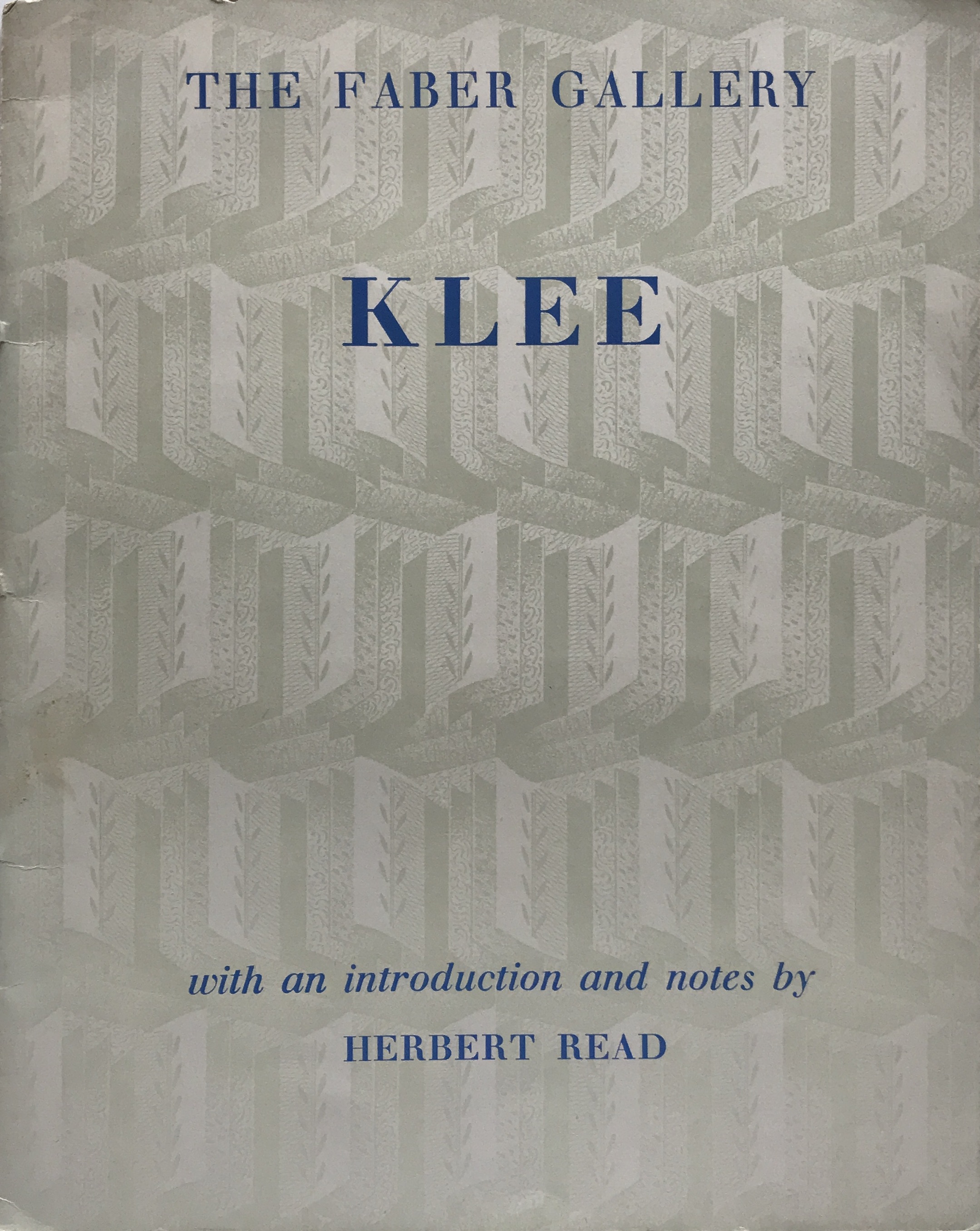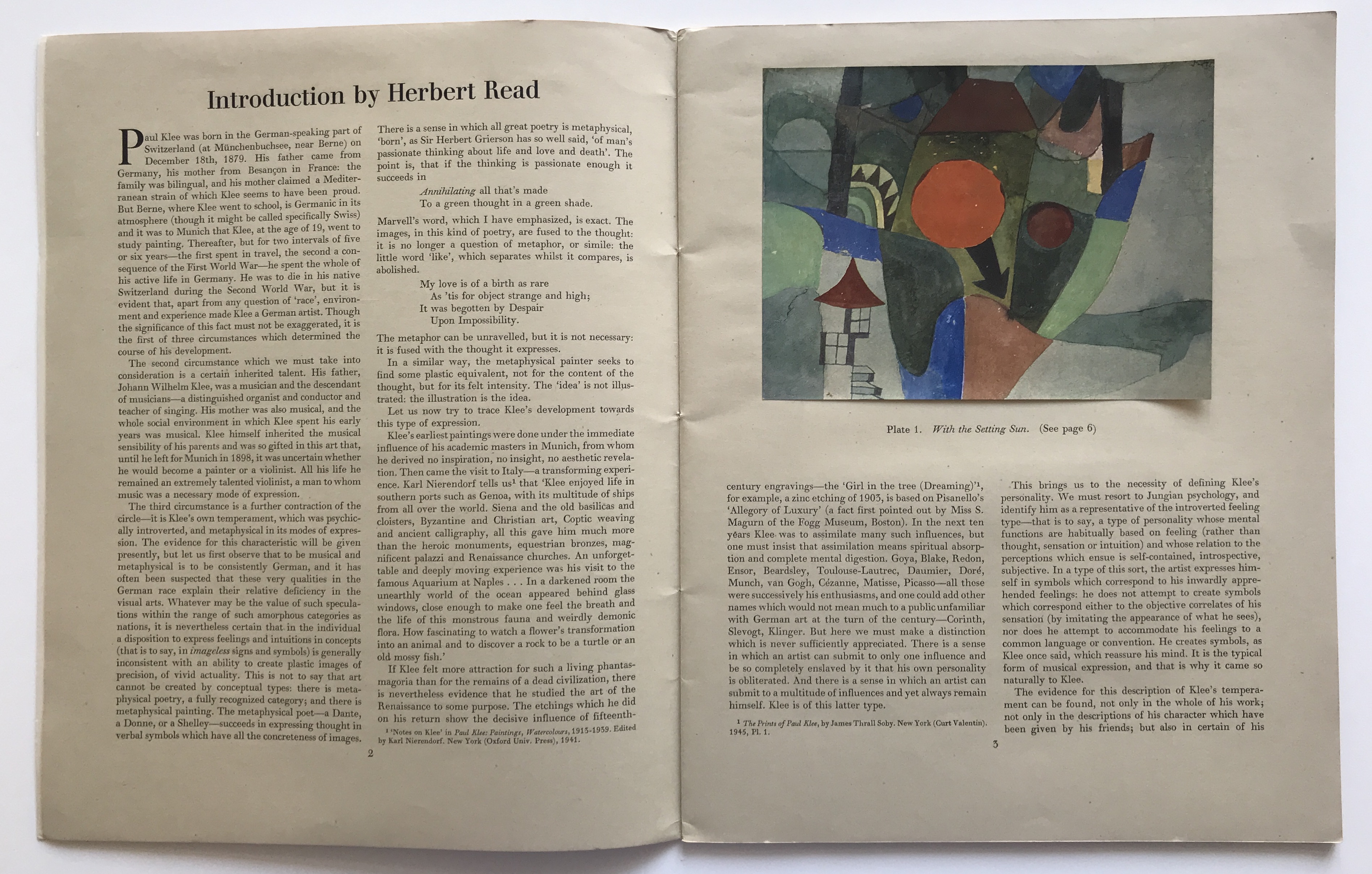Archive
Faber & Faber
- Faber & Faber
- Publishing House
Faber & Faber shows the importance of publishing houses as supporters of contemporary art movements and of the contribution of emigrants, helping to popularise their art and artistic theories.
Word Count: 29
24 Russell Square, Bloomsbury, London WC1 (until 1971); Bloomsbury House, 74–77 Great Russell Street, Holborn, London WC1 (now).

Klee. With an Introduction and Notes by Herbert Read. The Faber Gallery. Faber & Faber, 1948, cover (METROMOD Archive). 
Klee. With an Introduction and Notes by Herbert Read. The Faber Gallery. Faber & Faber, 1948, pp. 2–3 (METROMOD Archive). Breuer, Marcel. “Architecture and Material.” Circle. International Survey of Constructive Art, edited by J.L. Martín et al., Faber & Faber, 1937, pp. 193–202.
Browse, Lillian, editor. Augustus John: Drawings. Faber & Faber, 1941.
Browse, Lillian, editor. Sickert. Faber & Faber, 1943.
Browse, Lillian, editor. Constantin Guys. Faber & Faber, 1946.
Browse, Lillian, editor. Barbara Hepworth. Sculptress. Faber & Faber, 1946.
Browse, Lillian, editor. Degas dancers. Faber & Faber, 1949.
Faber & Faber. Letter to J. Martin. Ben Nicholson Papers (Tate Library and Archive, London, 7 November 1941), TGA 8717/1/2/1077.
Faber, Toby. Faber & Faber. The Untold Story. Faber & Faber, 2019.
Gabo, Naum. “The constructive idea in art.” Circle. International Survey of Constructive Art, edited by J.L. Martín et al., Faber & Faber, 1937, pp. 1–10.
Gropius, Walter. The New Architecture and the Bauhaus. Translated by P. Morton Shand, Faber & Faber, 1935.
Klee (The Faber Gallery). With an Introduction and Notes by Herbert Read. Faber & Faber, 1948.
Martín, J.L., et al., editors. Circle. International Survey of Constructive Art. Faber & Faber, 1937.
Moholy-Nagy, László. The New Vision. Fundamentals of Design, Painting, Sculpture, Architecture (New Bauhaus Books, 1). Translated by Daphne M. Hoffmann, Faber & Faber, 1939.
Pevsner, Nikolaus. Pioneers of the Modern Movement from William Morris to Walter Gropius. Faber & Faber, 1936.
Read, Herbert. Art Now. An Introduction to the Theory of Modern Painting and Sculpture. Faber & Faber, 1933.
Read, Herbert. Art and Industry. The Principles of Industrial Design. Faber & Faber, 1934.
Read, Herbert. “Paul Klee.” Paintings and Watercolours by Paul Klee, exh. cat. The Leicester Galleries, London, 1941, pp. 2–6.
Read, Herbert. “A Nest of Gentle Artists.” (1962) Art in Britain 1930–40 centred around Axis, Circle, Unit One, exh. cat. Marlborough Fine Art, London, 1965, pp. 7–8.
Word Count: 273
- 1929
- London
- Burcu Dogramaci. "Faber & Faber." METROMOD Archive, 2021, https://archive.metromod.net/viewer.p/69/1470/object/5145-11267251, last modified: 27-04-2021.
-
László Moholy-NagyPhotographerGraphic DesignerPainterSculptorLondon
László Moholy-Nagy emigrated to London in 1935, where he worked in close contact with the local avantgarde and was commissioned for window display decoration, photo books, advertising and film work.
Word Count: 30
Herbert ReadArt HistorianArt CriticPoetLondonThe British art historian Herbert Read established himself as a central figure in the London artistic scene in the 1930s and was one of the outstanding supporters of exiled artists.
Word Count: 30
Visual Pleasures from Everyday ThingsBookletLondonVisual Pleasures from Everyday Things is a booklet written in 1946 by the emigrated architectural historian Nikolaus Pevsner with the aim of aesthetic education and teacher training.
Word Count: 26
Farewell Dinner for Walter GropiusDinnerLondonFriends and colleagues came together on 9 March 1937 to send off the architect Walter Gropius and his wife Ise Gropius, who had decided to leave for the United States.
Word Count: 28
Roland, Browse & DelbancoGalleryArt DealerLondonÉmigré art historians and art dealers, Henry Roland and Gustav Delbanco, along with Lillian Browse, opened their Mayfair gallery, Roland, Browse & Delbanco, in 1945.
Word Count: 24
Marlborough Fine ArtArt GalleryLondonMarlborough Fine Art was founded in 1946 by the Viennese emigrants Harry Fischer and Frank Lloyd in the Mayfair district, focused on Impressionists, Modern and Contemporary Art.
Word Count: 26
Thames & HudsonPublishing HouseLondonThe emigrants Eva Feuchtwang (later Eva Neurath) and Walter Neurath founded the Thames & Hudson publishing house in 1949, which published art history books, photo books and collection catalogues.
Word Count: 28
Kurt SchwittersArtistPoetLondonThe artist and poet Kurt Schwitters lived in London between 1941 and 1945, where he stood in contact to émigré and local artists, before moving to the Lake District.
Word Count: 27
20th Century German ArtExhibitionLondonThe 20th Century German Art exhibition of 1938 gave visibility to artists who had been defamed at the Munich exhibition Entartete Kunst and were persecuted by the National Socialist regime.
Word Count: 29